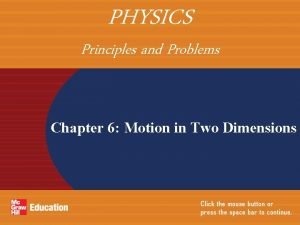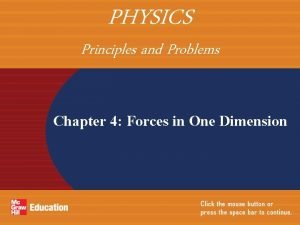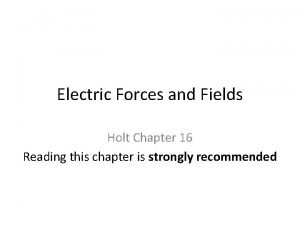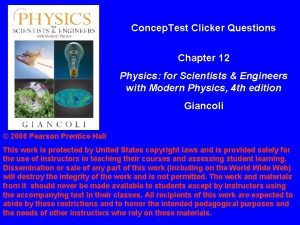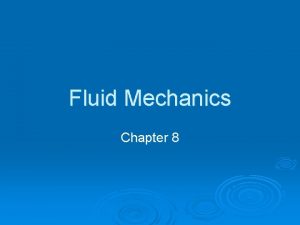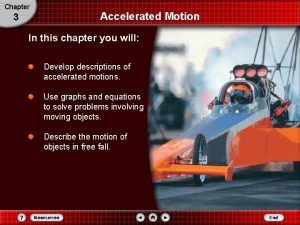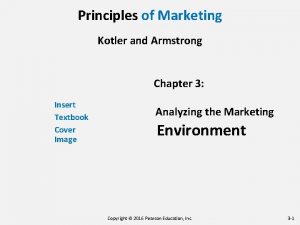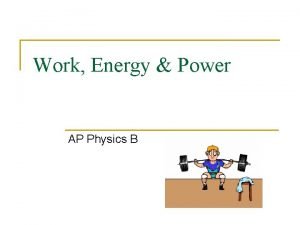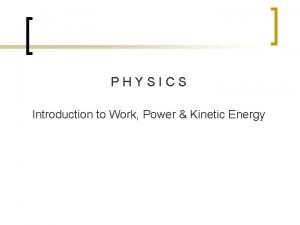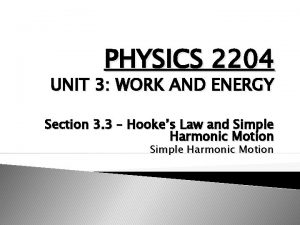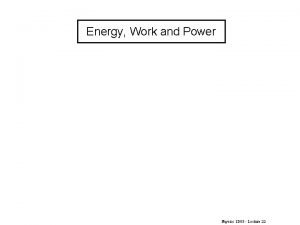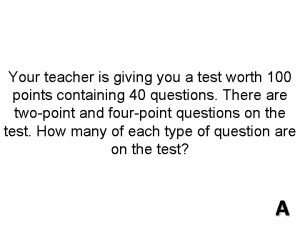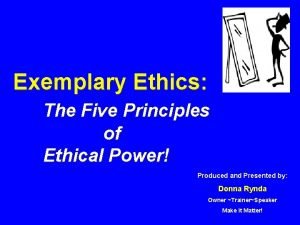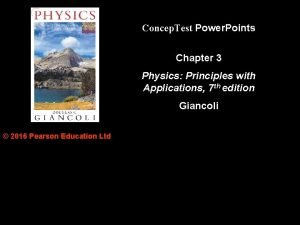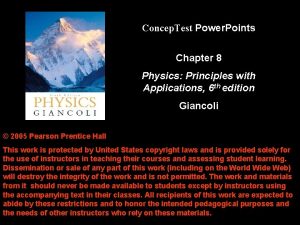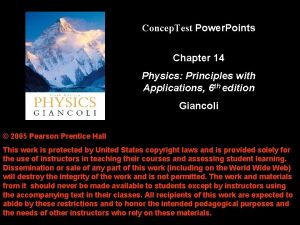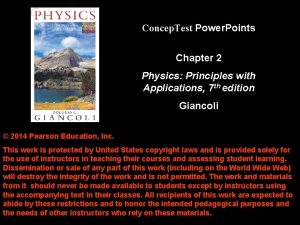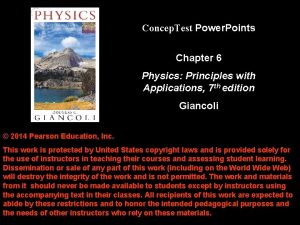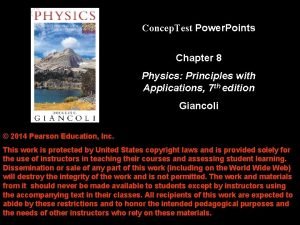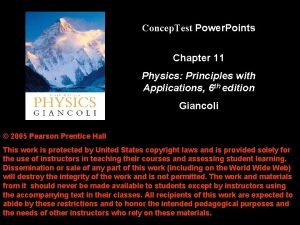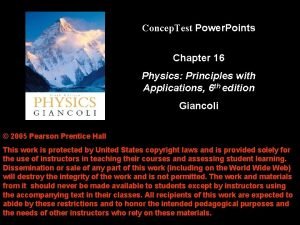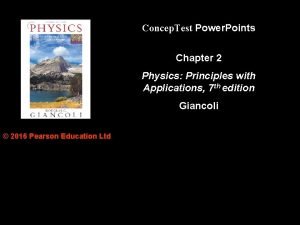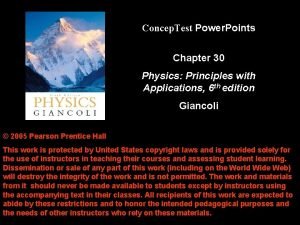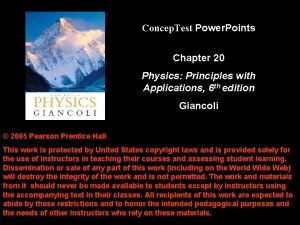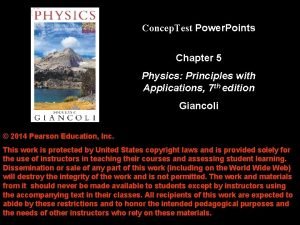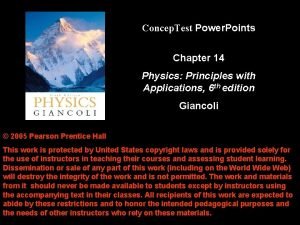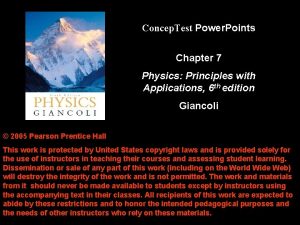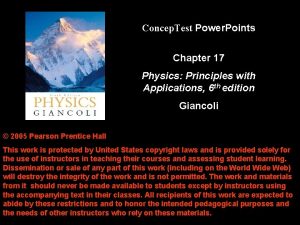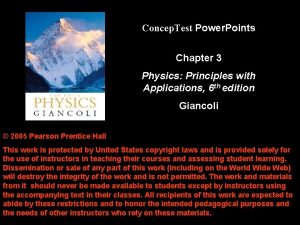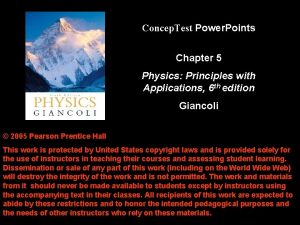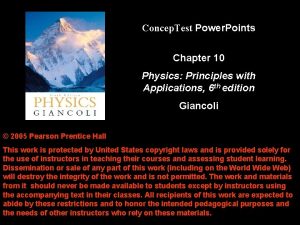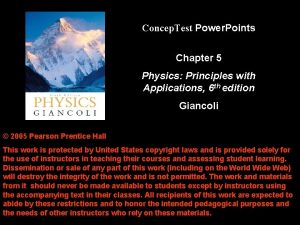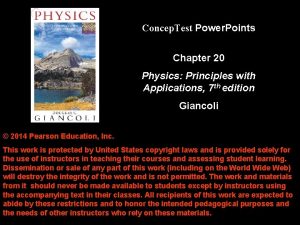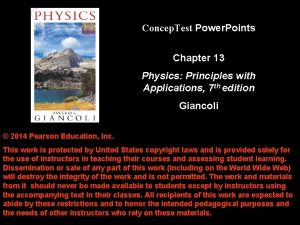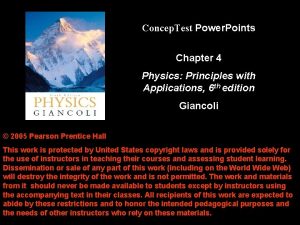Concep Test Power Points Chapter 13 Physics Principles

































- Slides: 33

Concep. Test Power. Points Chapter 13 Physics: Principles with Applications, 6 th edition Giancoli © 2005 Pearson Prentice Hall This work is protected by United States copyright laws and is provided solely for the use of instructors in teaching their courses and assessing student learning. Dissemination or sale of any part of this work (including on the World Wide Web) will destroy the integrity of the work and is not permitted. The work and materials from it should never be made available to students except by instructors using the accompanying text in their classes. All recipients of this work are expected to abide by these restrictions and to honor the intended pedagogical purposes and the needs of other instructors who rely on these materials.

Concep. Test 13. 1 Which is the largest unit: one Celsius degree, one Kelvin degree, or one Fahrenheit degree? Degrees 1) one Celsius degree 2) one Kelvin degree 3) one Fahrenheit degree 4) both one Celsius degree and one Kelvin degree 5) both one Fahrenheit degree and one Celsius degree

Concep. Test 13. 1 Which is the largest unit: one Celsius degree, one Kelvin degree, or one Fahrenheit degree? Degrees 1) one Celsius degree 2) one Kelvin degree 3) one Fahrenheit degree 4) both one Celsius degree and one Kelvin degree 5) both one Fahrenheit degree and one Celsius degree The Celsius degree and the Kelvin degree are the same size. The scales only differ by an offset, not by the size of the degree unit. For Fahrenheit, there are 180 degrees between boiling and freezing (212°F – 32°F). For Celsius, there are 100 degrees between the same points, so the Celsius (and Kelvin) degrees must be larger.

Concep. Test 13. 2 Freezing Cold It turns out that – 40°C is the same temperature as – 40°F. Is there a temperature at which the Kelvin and Celsius scales agree? 1) yes, at 0 °C 2) yes, at -273 °C 3) yes, at 0 K 4) no

Concep. Test 13. 2 Freezing Cold It turns out that – 40°C is the same temperature as – 40°F. Is there a temperature at which the Kelvin and Celsius scales agree? 1) yes, at 0 °C 2) yes, at -273 °C 3) yes, at 0 K 4) no The Celsius and Kelvin scales differ only by an offset, which is 273 degrees. Therefore, a temperature on one scale can never match the same numerical value on the other scale. The reason that such agreement is possible for Celsius and Fahrenheit is the fact that the actual degree units have different sizes (recall the previous question).

Concep. Test 13. 3 Thermometers 1) the mercury contracts before the You may notice that if a glass contracts mercury-in-glass thermometer 2) the glass contracts before the mercury contracts is inserted into a hot liquid, the 3) the mercury contracts before the mercury column first drops, glass expands and then later starts to rise (as 4) the glass expands before the you expect). How do you mercury expands explain this drop? 5) the mercury expands before the glass contracts

Concep. Test 13. 3 Thermometers 1) the mercury contracts before the You may notice that if a glass contracts mercury-in-glass thermometer 2) the glass contracts before the mercury contracts is inserted into a hot liquid, the 3) the mercury contracts before the mercury column first drops, glass expands and then later starts to rise (as 4) the glass expands before the you expect). How do you mercury expands explain this drop? 5) the mercury expands before the glass contracts The hot liquid touches the glass first, so initially the glass expands slightly. This increases the volume inside the glass, and so the mercury level drops slightly. Once the mercury heats up, it begins to expand then the characteristic rise in the mercury column follows, indicating the increase in temperature that you expected to measure. Follow-up: Is it possible to have the mercury first rise and later drop?

Concep. Test 13. 4 Glasses 1) run hot water over them both Two drinking glasses are stuck, one inside the other. How would you get them unstuck? 2) put hot water in the inner one 3) run hot water over the outer one 4) run cold water over them both 5) break the glasses

Concep. Test 13. 4 Glasses 1) run hot water over them both Two drinking glasses are stuck, one inside the other. How would you get them unstuck? 2) put hot water in the inner one 3) run hot water over the outer one 4) run cold water over them both 5) break the glasses Running hot water only over the outer glass will allow the outer one to expand, expand while the inner glass remains relatively unchanged. This should loosen the outer glass and free it.

Concep. Test 13. 5 a Steel Expansion I A steel tape measure is marked such that it gives accurate length measurements 1) measured lengths will be too small at room temperature. If the 2) measured lengths will still be accurate tape measure is used outside on a very hot day, how will its 3) measured lengths will be too big length measurements be affected?

Concep. Test 13. 5 a Steel Expansion I A steel tape measure is marked such that it gives accurate length measurements 1) measured lengths will be too small at room temperature. If the 2) measured lengths will still be accurate tape measure is used outside on a very hot day, how will its 3) measured lengths will be too big length measurements be affected? The tape measure will expand, so its markings will spread out farther than the correct amount. When it is laid down next to an object of fixed length, you will read too few markings for that given length, so the measured length will be too small.

Concep. Test 13. 5 b Steel Expansion II Metals such as brass expand when heated. The thin brass plate in the movie has a circular hole in its center. When the plate is heated, what will happen to the hole? 1) gets larger 2) gets smaller 3) stays the same 4) vanishes

Concep. Test 13. 5 b Steel Expansion II Metals such as brass expand when heated. The thin brass plate in the movie has a circular hole in its center. When the plate is heated, what will happen to the hole? 1) gets larger 2) gets smaller 3) stays the same 4) vanishes Imagine drawing a circle on the plate. This circle will expand outward along with the rest of the plate. Now replace the circle with the hole, and you can see that the hole will expand outward as well. Note that the material does NOT “expand inward” to fill the hole!! expansion

Concep. Test 13. 6 a Steel Ring I A steel ring stands on edge with a rod of some material inside. As this system is heated, for which of the following rod materials will the rod eventually touch the top of the ring? 1) aluminum 2) steel 3) glass 4) aluminum and steel 5) all three Quartz Glass Steel Al Hg Air Coefficient of volume expansion b (1/°C )

Concep. Test 13. 6 a Steel Ring I A steel ring stands on edge with a rod of some material inside. As this system is heated, for which of the following rod materials will the rod eventually touch the top of the ring? 1) aluminum 2) steel 3) glass 4) aluminum and steel 5) all three Quartz Glass Steel Al Hg Air Coefficient of volume expansion b (1/°C ) Aluminum is the only material that has a larger b value than the steel ring, so that means that the aluminum rod will expand more than steel ring Thus, only in that case does the rod have a chance of reaching the top of the steel ring.

Concep. Test 13. 6 b Steel Ring II You want to take apart a couple of 1) heat the thing up aluminum parts held together by 2) cool the thing down steel screws, but the screws are 3) blow the thing up stuck. What should you do? Quartz Glass Steel Al Hg Air Coefficient of volume expansion b (1/°C )

Concep. Test 13. 6 b Steel Ring II You want to take apart a couple of 1) heat the thing up aluminum parts held together by 2) cool the thing down steel screws, but the screws are 3) blow the thing up stuck. What should you do? Quartz Glass Steel Al Hg Air Coefficient of volume expansion b (1/°C ) Since aluminum has a larger b value, value that means aluminum expands more than steel Thus, by heating the part, the aluminum holes will expand faster than the steel screws and the screws will come loose.

Concep. Test 13. 7 Grandfather Clock A grandfather clock uses a brass pendulum to keep perfect time at 1) clock will run slower than usual room temperature. If the air 2) clock will still keep perfect time conditioning breaks down on a very hot summer day, how will the 3) clock will run faster than usual grandfather clock be affected?

Concep. Test 13. 7 Grandfather Clock A grandfather clock uses a brass pendulum to keep perfect time at 1) clock will run slower than usual room temperature. If the air 2) clock will still keep perfect time conditioning breaks down on a very hot summer day, how will the 3) clock will run faster than usual grandfather clock be affected? The pendulum will expand, so its length will increase. The period of a pendulum depends on the length as shown below, so the period will also increase. Thus, the clock will run slow. T = 2 p (L / g ) Follow-up: Roughly by how much will it run slower?

Concep. Test 13. 8 a Nitrogen and Oxygen I Which has more molecules – a mole of nitrogen (N 2) gas or a mole of oxygen (O 2) gas? 1) oxygen 2) nitrogen 3) both the same

Concep. Test 13. 8 a Nitrogen and Oxygen I Which has more molecules – a mole of nitrogen (N 2) gas or a mole of oxygen (O 2) gas? 1) oxygen 2) nitrogen 3) both the same A mole is defined as a quantity of gas molecules equal to Avogadro’s number (6. 02 1023). This value is independent of the type of gas.

Concep. Test 13. 8 b Nitrogen and Oxygen II Which weighs more – a mole 1) oxygen of nitrogen (N 2) gas or a mole 2) nitrogen of oxygen (O 2) gas? 3) both the same

Concep. Test 13. 8 b Nitrogen and Oxygen II Which weighs more – a mole 1) oxygen of nitrogen (N 2) gas or a mole 2) nitrogen of oxygen (O 2) gas? 3) both the same The oxygen molecules have a molecular mass of 32, while the nitrogen molecules have a molecular mass of 28. Follow-up: Which one will take up more space?

Concep. Test 13. 9 a Ideal Gas Law I Two identical cylinders at the same 1) cylinder A temperature contain the same gas. If 2) cylinder B A contains three times as much gas as B, which cylinder has the higher pressure? 3) both the same 4) it depends on temp. T

Concep. Test 13. 9 a Ideal Gas Law I Two identical cylinders at the same 1) cylinder A temperature contain the same gas. If 2) cylinder B A contains three times as much gas as B, which cylinder has the higher 3) both the same 4) it depends on temp. T pressure? Ideal gas law: PV = n. RT Solve for pressure: P = n. RT / V For constant V and T, the one with more gas (the larger value of n) has the higher pressure P.

Concep. Test 13. 9 b Ideal Gas Law II Two identical cylinders at the same 1) cylinder A pressure contain the same gas. If A 2) cylinder B contains three times as much gas as 3) both the same B, which cylinder has the higher temperature? 4) it depends on the pressure P

Concep. Test 13. 9 b Ideal Gas Law II Two identical cylinders at the same 1) cylinder A pressure contain the same gas. If A 2) cylinder B contains three times as much gas as 3) both the same B, which cylinder has the higher temperature? 4) it depends on the pressure P Ideal gas law: PV = n. RT Solve for temperature: T = PV / n. R For constant V and P, the one with less gas (the smaller value of n) has the higher temperature T.

Concep. Test 13. 9 c Two identical cylinders at the same temperature contain the same gas. If B has twice the volume and half Ideal Gas Law III 1) PB = 1/2 PA 2) PB = 2 PA the number of moles as A, how does 3) PB = 1/4 PA the pressure in B compare with the 4) PB = 4 PA pressure in A? 4) PB = PA

Concep. Test 13. 9 c Two identical cylinders at the same temperature contain the same gas. If B has twice the volume and half Ideal Gas Law III 1) PB = 1/2 PA 2) PB = 2 PA the number of moles as A, how does 3) PB = 1/4 PA the pressure in B compare with the 4) PB = 4 PA pressure in A? 4) PB = PA Ideal gas law: PV = n. RT Since B has a factor of two more volume, it has a factor of two less pressure. But B also has half the amount of gas, so that is another factor of two reduction in pressure. Thus, B must have only 1/4 the pressure of A.

Concep. Test 13. 10 A plastic soda bottle is empty and sits out in the sun, heating the air inside. Now you put the cap on tightly and put the bottle in the fridge. What happens to the bottle as it cools? Soda Bottle 1) it expands and may burst 2) it does not change 3) it contracts and the sides collapse inward 4) it is too dark in the fridge to tell

Concep. Test 13. 10 A plastic soda bottle is empty and sits out in the sun, heating the air inside. Now you put the cap on tightly and put the bottle in the fridge. What happens to the bottle as it cools? Soda Bottle 1) it expands and may burst 2) it does not change 3) it contracts and the sides collapse inward 4) it is too dark in the fridge to tell The air inside the bottle is warm, warm due to heating by the sun. When the bottle is in the fridge, the air cools As the temperature drops, the pressure in the bottle also drops Eventually, the pressure inside is sufficiently lower than the pressure outside (atmosphere) to begin to collapse the bottle.

Concep. Test 13. 11 What happens to the volume of a balloon if you put it in the freezer? Balloon in Freezer 1) it increases 2) it does not change 3) it decreases

Concep. Test 13. 11 What happens to the volume of a balloon if you put it in the freezer? Balloon in Freezer 1) it increases 2) it does not change 3) it decreases According to the Ideal Gas Law, when the temperature is reduced at constant pressure, pressure the volume is reduced as well. The volume of the balloon therefore decreases. PV = n. RT Follow-up: What happens to the volume when the balloon rises in the air?
 Gamit ang concept map ibigay ang mga bahagi ng manwal
Gamit ang concept map ibigay ang mga bahagi ng manwal Power trianlge
Power trianlge Straddle positioning example
Straddle positioning example Point of difference and point of parity
Point of difference and point of parity Physics principles and problems chapter 6 answers
Physics principles and problems chapter 6 answers Physics chapter 4 study guide
Physics chapter 4 study guide Representing motion physics answers chapter 2
Representing motion physics answers chapter 2 Holt physics chapter 16 test
Holt physics chapter 16 test Chapter 12 physics test
Chapter 12 physics test Chapter 8 fluid mechanics
Chapter 8 fluid mechanics Chapter 3 accelerated motion practice problems answers
Chapter 3 accelerated motion practice problems answers Coso framework
Coso framework Prayer points for power and authority
Prayer points for power and authority Why does it happen
Why does it happen University physics with modern physics fifteenth edition
University physics with modern physics fifteenth edition Physics hl ia ideas
Physics hl ia ideas Principles of marketing chapter 3
Principles of marketing chapter 3 Principles of ecology 1 organisms and their relationships
Principles of ecology 1 organisms and their relationships Power ap physics
Power ap physics Regents physics work power energy
Regents physics work power energy Watt definition
Watt definition Work versus power
Work versus power Work power definition
Work power definition Unit of resistivity
Unit of resistivity Physics 2204 unit 3: work, power, energy
Physics 2204 unit 3: work, power, energy Physics 1d03
Physics 1d03 One night a theater sold 548 movie tickets
One night a theater sold 548 movie tickets Esterman efficiency score 92
Esterman efficiency score 92 Principles of ethical power for organization
Principles of ethical power for organization Solar power satellites and microwave power transmission
Solar power satellites and microwave power transmission Potential power
Potential power Flex28024a
Flex28024a Resolving power and dispersive power of grating
Resolving power and dispersive power of grating Power of a power property
Power of a power property




